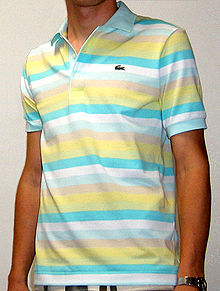Piqué (weaving)

Piqué, or marcella, refers to a weaving style, normally used with cotton yarn, which is characterized by raised parallel cords or geometric designs in the fabric.[1] Piqué fabrics vary from semi-sheer dimity to heavy weight waffle cloth.[1] Twilled cotton and corded cotton are close relatives.
Name
The name piqué is derived from the French word Piquer, meaning 'quilt'; late 18th-century piqué fabrics were considered to imitate a hand-made quilt.[2]
Piqué weave
The weave is closely associated with
Piqué weaving
Piqué weaving was developed by the Lancashire cotton industry in the late 18th century as a mechanised technique of weaving double cloth with an enclosed heavy cording weft.[citation needed] It was originally used to make imitations of the corded Provençal quilts made in Marseille, the manufacture of which became an important industry for Lancashire from the late 18th to the early 20th century.[citation needed] The term "marcella", another name for piqué, is one of a number of variations on the word "Marseille".[3]
Fabrics
Woven piqué
Piqué fabrics are a type of
blends and even pure silk versions were made in the past and in a variety of weaves. [4]Knitted piqué

Piqué knit is a double knit that forms a structure with pronounced wales. The knit type is possible with warp and weft, both knitting techniques. The texture is used in polo shirts.[5][6]
Structure
Knitted piqué has a grained surface on the face and plain single jersey on the other side. The construction is open and prone to shrink more than single jersey. The knit can produce many variants such as single pique, double pique and more; it is also known as Lacoste piqué for the company's use of the fabric in its signature polo shirts.[7][8][9]
References
- ^ ISBN 9780471606406.
- ISBN 978-0-393-01703-8.
- ^ Atkins, Jacqueline M. (2001), "From lap to loom: The transition of Marseilles white work from hand to machine", The Chronicle of the Early American Industries Association, Inc, retrieved 2010-05-02
- ISBN 9780916434113.
- ISBN 978-0-598-48380-5.
- ^ The Indian Textile Journal. Indian Textile Journal Limited. 2013. p. 108.
- ISBN 978-1-55850-729-6.
- ^ The Bulletin. J. Haynes and J.F. Archibald. March 1993. p. 72.
- ISBN 978-0-08-102769-1.

